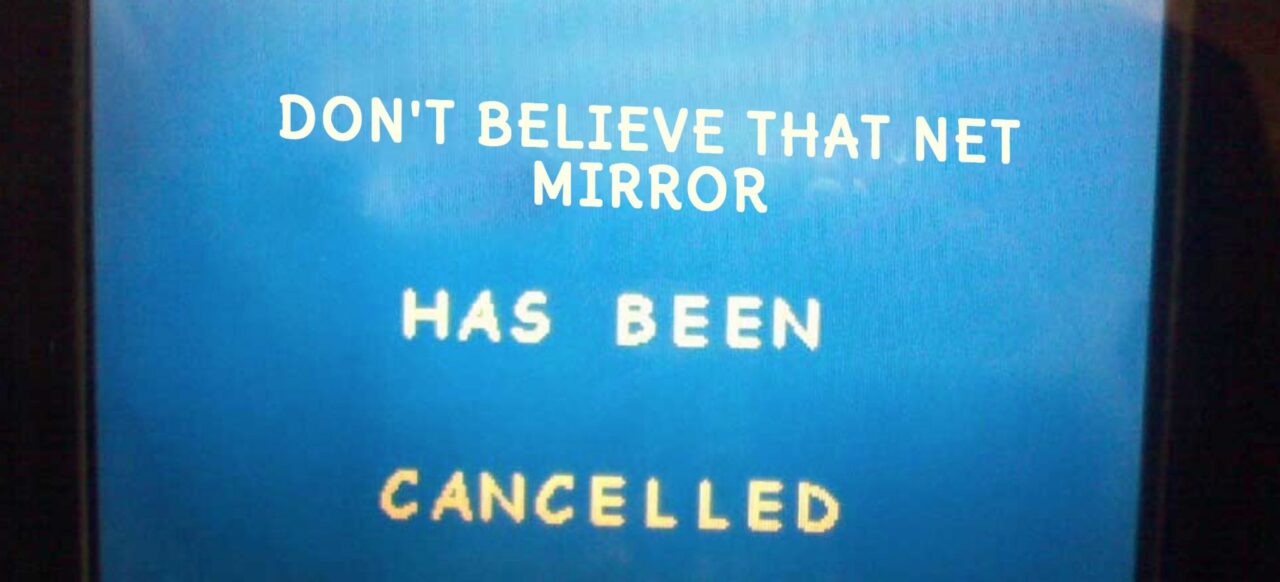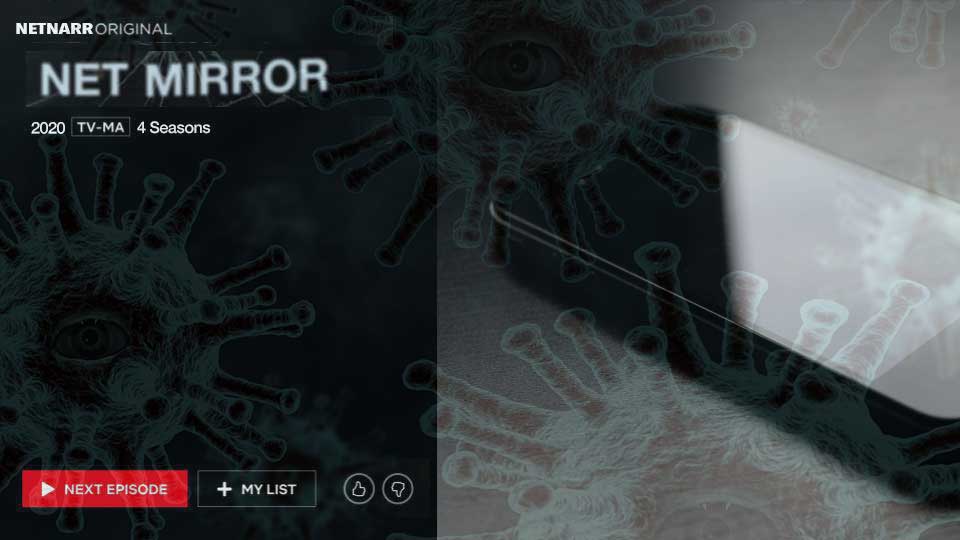Oops.
Speaking of slacking on the blogging, the last post here on this year’s Networked Narratives class was the first one about this year’s class.
This fourth iteration of this change it up every year course co-taught with Mia Zamora at Kean University mixed things up from previous years. More on that soon.
From the start, the theme/metaphor is a 100% rip off (done with total respect, natch) of Black Mirror. And what we did towards the latter half was an activity I wanted to do since reading Anne-Marie Scott’s post in October 2019 about her experience at a MozFest workshop called the Black Mirror Writers’ Room.
Created by CU Boulder professor Casey Fiesler as an ethics class activity, the premise is to use the near term dystopian future genre of Black Mirror as a vehicle to explore the ethical considerations of technology. More or less, the idea is to imagine a current or projected data surveillance technology, consider the implications, and cast it as a plot for a Black Mirror Episode For more, see the presentation slides from the Mozfest workshop (designed to be reused) and the examples created by participants.
I liked how the slides take technologies that exist now that are directly related to existing Black Mirror Episodes:
To scaffold this as a teaching exercise, the following sets of slides are intended to show the relationship between current technologies/social implications/ethical controversies and real episodes of Black Mirror.
A reason that Black Mirror is so compelling is that it often builds upon our existing anxieties about technology and pushes them just a step farther. This is the perfect place to build from when using creative speculation to think through the possible consequences of new technology.
https://tinyurl.com/blackmirrorwritersroom
I can’t recommend enough Casey Fiesler’s article Black Mirror, Light Mirror: Teaching Technology Ethics Through Speculation.
All of this was a preamble to say that after reading Anne Marie’s post and its links, I so wanted to find a way to use this as an activity. Yup, I commented that October 28, 2019.
When Mia and started our planning, she was willing to use the Black Mirror Metaphor (I recast as Net Mirror) in the vein of like the way Charlie Brooker describes the meaning of his show’s name to extend to what it mans when we look into the black screens not knowing what the networks behind them are doing.
The general plan of the course was a front half exploring Digital Citizenship, Social Media Literacy, Participatory Culture, Digital Self Representation, and Surveillance Capitalism. Our group of grad students met Thursday’s at Kean in Liberty Hall. They each adopted a topic and were responsible for summarizing the readings into a class session.
My bit was beaming in for the second half of class for leading some hands on activities. Instead of doing separate student blogs and syndication, we went simpler by having the students post to the class blog. We encouraged tweeting, but did not make it expected (it’s more interesting to see how students adapt to choosing it if it provides value).
I had hopes of doing more hypothes.is annotation but that always seems to fall off the table. I have a dream of doing a class one day where that is the only place of group communication and discussion.
The aim was towards late march to introduce the students to the brilliant Screening Surveillance series conceived and brought to life by sava saheli singh. These shorts films are done totally in the Black Mirror genre and we were optimistic because we know sava, that we could convince her to join us in class for a discussion.
The course would turn in April to what I like best, the media creation. We wanted our students to create some kind of story in the same genre we now referred to as speculative fiction. The hope was maybe to have students do audio stories (maybe my favorite thing to teach).
Things hummed along nicely. We like to think we teach this in a dynamic means where things are changed/created weekly. But we did not plan for what fell in March (although I was following/worrying about Covid-19 in January).

Now the entire class would operate in my mode… remote. The first week of lockdown, we took everything off the schedule, to give room to deal with the shock and change. We met in class time, but used the time just to check in.
So more adjustment happened. The plan for in April for the students to present issues of privacy and surveillance at the Kean Research days morphed into a student blogged summary and video presentation based on Digital Detox.
We wrapped the discussions of the Screening Surveillance series into the early April OER20 Conference where sava was a keynote and Mia had a full plate as a conference co-chair. In lieu of class that week we asked the students to participate in the conference, especially the keynote where the film Frames was screened and sava was there to discuss the film.
The following week we were able to have sava (and Chris Gilliard) join us for a watching of and a discussion of Blaxites, maybe the best session of all (to me). In the time where people were talking about Zoom Fatigue, our class went close to three hours, and it was more energetic at the end than the start.
The final project was getting closer and we had to make adjustments to what would be possible and still provide sufficient creativity. I built out a library of speculative fiction examples in audio, video, and web forms- choosing relevant episodes from The Truth (podcast), Black Mirror, The Twilight Zone and more (one of the best things I heard from the student reflections was their interest and appreciation for the Twilight Zone).
In the end, rather than doing a full story development, we had them generate the concept for a story including character, a plot pitch, scene, gifs, memes, and as much plot they could conceive, and a bit of a cliff hanger. These are all published now as in the Arganee Journal (cough, TRU Writer SPLOT).
Getting there was creating a version of the Black Mirror Writers’ Room as a Net Mirror flavored one (https://bit.ly/netmirror-writersroom)
Where the students had chosen their technology gone surveillant and created a Netflix-like episode image (like Casey Fiesler’s workshop we used Google Slides). See these at https://bit.ly/netmirror-writersroom-episodes
We tossed in the use of memes and GIFs as a sideways intro to making media, but also to consider them in a less than typical format. So I like to use making GIFs from videos as a way to isolate and examine key scenes. And we asked them to use memes not as reactions or “ha ha” but to string together a sequence as conversation as well as to illustrate their ending “what comes next?”
I also like to open their eyes to the difference between the normal use of these media for sharing (just using what others made) to making their own. As usual, students really rise to an impressive creative level here.
The real work over the last weeks was our class sessions where the students shared their plot ideas. The hardest part was getting them to shift from the idea of surveillance as the “someone is spying on me” or using technology to take advantage of another to the broader use of surveillance technology to more subtly influence larger numbers of people. And in ways they do not see directly what the intent is. And that it is done often by entities we don’t see.
It’s the challenge is that many of our ideas of surveillance are wrapped in the framework of cameras and devices “spying” on us.
I do regret we did not have part of the class a video essay that ironically has the same title as sava’s series. I had scoped out Steve Anderson’s video essay “Screening Surveillance” (2015) before class, but we did not work it into the schedule. I think it might have helped push the thinking of how data surveillance goes beyond our pre-conceptions.
“Screening Surveillance” offers an interpretive chronology of surveillance in Hollywood from Charlie Chaplin to Edward Snowden. Composed entirely of clips from American film and television, Screening Surveillance maps the evolution of cultural discourses surrounding government surveillance, taking note of shifts from optical to computational surveillance and analyzing the ways this discourse has – and has not – changed since the revelations about NSA surveillance by government contractor Edward Snowden in June 2013.
Film and television have historically associated surveillance with voyeurism in order to warn of the threat it poses to individual privacy and freedom. But the nature and significance of government surveillance has changed dramatically since the beginning of the computer age. In the realm of computational surveillance – specifically, the large-scale collection and mining of metadata – the power of looking is trumped by the power of knowing. Yet, when the cameras of Hollywood envision data surveillance, they often remain rooted in the visual realm, ignoring the very real threats to freedom and privacy that attend today’s large scale data mining. Hollywood’s preference for visual spectacle is certainly understandable, but the industry’s broader inability to represent technological complexity disserves its ability to engage important social issues, simply because they are not readily visualized.
http://mediacommons.org/intransition/2015/03/11/screening-surveillance
We spent a great deal of time working to have our students understand this difference. Since we had discussed Frames and Blaxites, I often leaned on them as examples. “Jai did not expect her social media data to be connected to her health care” or “Who is benefitting from the data tracking in Frames? Why do we never see them?”
And that what we had asked of them was a difficult task. The point was not producing something like the shows that had watched, but working through the process, and struggling to find that same “hook”of Black Mirror and Screening Surveillance.
The students really went farther with developing plots and characters than I even imagined. And each Net Mirror concept is quite different from each other. Again, please check them out (leave comments!) http://journal.arganee.world/issues/issue-6-contents/
The real telling was in their submitted reflections to hear how much they opened their eyes to data surveillance, something most had never even considered before. They leave with a bit more side eye glance at their screens and devices.
I could not be more impressed with the bonding in this group; it was strong before the lockdown, but their perseverance through this period was humbling to me. Located in northern New Jersey, Kean is proximal to the Covid-19 giant red dot that grows from New York City. Students and families were directly affected by the pandemic, it was more than an inconvenience.
And yet, week after week they came to our Google Meet sessions, were completely present and often too apologetic like “sorry my blog post is late.”
I could not be more humbled and proud of this year’s NetNarr crew. They were sad the class was over. “Can’t we keep doing this?”
It did not end, when after the end of class an email came with a “recipe book” Google Slide deck that was an expression of appreciation of the whole class.
I cannot sufficiently thank and appreciate our students Medea, Linda, Ryan, Patricia, Dylan, Nives, and Kevin for a never wavering effort in this class. It fit the tagline we created at the beginning (not planning for an effing pandemic) “not necessarily dystopia.”
This post is long but does not give justice to all this group did; that is left for you to explore in the course site http://netmirror.arganee.world/
And with that, the Net Mirror goes dark…
For now.
Featured Image: A mashup of our NetMirror template for the story concept, a CC0 pikrepo image of a black iphone, and Covid virus Image by Syaibatul Hamdi from Pixabay


